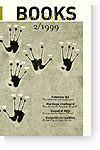
|
You can read some of Books from Finland here: click the links
Editorial
This'n'that
Ann-Christine Snickars on Susanne Ringell; Bror Rönnholm on
the poet Mårten Westö; literary prizes; the publication
of Jean Sibelius's collected compositions; Bookclub 'Knowledge';
the limits of literature discussed at the Lahti International Writers'
Reunion
Susanne Ringell
Cause of death
A short story from Åtta kroppar ('Eight bodies', Söderströms,
1998), translated by David McDuff
Susanne Ringell (born 1955) examines people's relationships with
their own bodies - as well as with other people's souls. In this
story she puts two people in a boat: a middle-aged couple who know
they should throw their marriage overboard
Mårten Westö
Breathe out, breathe in
Poems from Nio dagar utan namn ('Nine days without names',
Söderströms, 1998), translated by David McDuff
In his third collection, the Finland-Swedish poet Mårten Westö
(born 1967) rides the buses and trams of his native Helsinki, contemplating
silence, childhood and the visibility of things
Veijo Meri
Arms and the man
A short story from Leiri ('Camp') and commentary ('Afterthought',
both published by Otava, 1972 and 1985), translated by Herbert Lomas
The novelist, dramatist and poet Veijo Meri (born 1928), widely
translated and revered since the early days of the 1950s Finnish
modernism, is also a short-story writer who likes to set traps to
ensnare his readers. In an interview with Maija Alftan, he describes
his passion for reading and his feelings about growing older
Kalevala
In 1849 a country doctor, Elias Lönnrot,
published his second, enlarged collection of folk poems that subsequently
became the Finnish national epic, the Kalevala. In a special
section, Books from Finland celebrates the 150th anniversary
of this 'New' Kalevala with a selection of approaches to
the epic, both visual and verbal
Recreating the Kalevala
In his illustrations for a new edition of the Kalevala,
the artist Hannu Väisänen has sought links between the
Kalevala and other great epics and cultures of the world
To whom does the Kalevala belong?
The folk poems of the epic were collected in Karelia, which has historically
belonged partly both to Finland and to Russia. Timo Vihavainen
takes a look at the history of Finnish and Russian attitudes to
the 'national identity' of the Kalevala
Songlands of the Kalevala
Elias Lönnrot carried no camera on his journeys in eastern
Karelia, but Into Konrad Inha did, when he travelled among its
poor, remote villages in the 1890s. The artist and photographer
Ismo Kajander explores Inha's classic early photographic documentary
On translating the Kalevala
The Kalevala has been translated into Swedish a couple
of times, but in 1996 the poet Lars Huldén was asked to
make a new version. He describes the daunting task
Kalevala rhythms
The French-Caribbean writer Patrick Chamoiseau - who won the Prix
Goncourt in 1992 with his novel Texaco - travelled to Finland
and encountered the rhythms of the Kalevala
Reviews
Kirsi Leiman
Making waves
Books on Alvar Aalto in English, published in his centenary year 1998
Arto Mansala
Beyond Finlandisation
Finland in the New Europe by Max Jakobson
Kalevi Rikkinen
'From geology to theology'
Suomen kartasto 1999 (6. laitos, 100-vuotisjuhlakartasto) [Atlas
of Finland 1999. Sixth, centenary edition], edited by John Westerholm
& Pauliina Raento
New translations
Select bibliography
Lars Sund
Letter from Uppsala
Top of page
|

